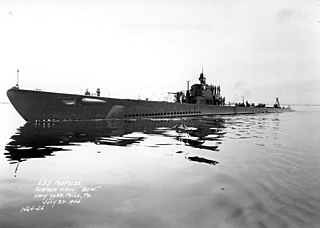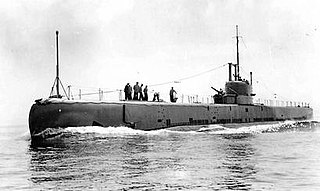Eleven vessels of the Royal Navy have been named HMS Grampus after two members of the dolphin family (Delphinidae): Grampus griseus, also known as Risso's dolphin, and Orcinus orca, also known as the killer whale.

HMS Grampus (N56) was the lead ship of her class of mine-laying submarine of the Royal Navy. She was built at Chatham Dockyard and launched on 25 February 1936. She served in World War II off China before moving to the Mediterranean Sea. She was sunk with all hands by the Regia Marina on 16 June 1940.

The Porpoise class were submarines built for the United States Navy in the late 1930s, and incorporated a number of modern features that would make them the basis for subsequent Salmon, Sargo, Tambor, Gato, Balao, and Tench classes. In some references, the Porpoises are called the "P" class.

The British C-class submarines were the last class of petrol engined submarines of the Royal Navy and marked the end of the development of the Holland class in the Royal Navy. Thirty-eight were constructed between 1905 and 1910 and they served through World War I.

The D-class submarine was the Royal Navy's first class of submarines capable of operating significantly beyond coastal waters. They were also the first boats to be fitted with wireless transmitters. Ten were laid down between 1907 and 1910, though only 8 were completed as D-class boats. The final two hulls were completed as British E-class submarine.

HMS C12 was one of 38 C-class submarines built for the Royal Navy in the first decade of the 20th century. The boat survived the First World War and was sold for scrap in 1920.

HMS C14 was one of 38 C-class submarines built for the Royal Navy in the first decade of the 20th century. The boat survived the First World War and was sold for scrap in 1920.

HMS C16 was one of 38 C-class submarines built for the Royal Navy in the first decade of the 20th century. The boat survived the First World War and was sold for scrap in 1922.
HMS C24 was one of 38 C-class submarines built for the Royal Navy in the first decade of the 20th century. The boat survived the First World War and was sold for scrap in 1921.
HMS C26 was one of 38 C-class submarines built for the Royal Navy in the first decade of the 20th century.

HMS C38 was one of 38 C-class submarines built for the United Kingdom Royal Navy in the first decade of the 20th century. The boat survived the First World War and was sold for scrap in 1919.
HMS C35 was one of 38 C-class submarines built for the Royal Navy in the first decade of the 20th century.
HMS C27 was one of 38 C-class submarines built for the Royal Navy in the first decade of the 20th century.

HMS L4 was a L-class submarine built for the Royal Navy during World War I. The boat survived the war and was sold for scrap in 1934.
HMS Porpoise (N14) was one of the six-ship class of Grampus-class mine-laying submarines of the Royal Navy. She was built at Vickers Armstrong, Barrow and launched 30 August 1932. She served in World War II in most of the naval theatres of the war, in home waters, the Mediterranean and the Far East. She was sunk with all hands by Japanese aircraft on 19 January 1945, and was the last Royal Navy submarine to be lost to enemy action.

HMS Narwhal (N45) was one of the six ship class of Grampus-class mine-laying submarine of the Royal Navy. She was built by Vickers Armstrong, Barrow and launched 29 August 1935. She served in the Second World War in home waters. She was lost in the North Sea on 23 July 1940, probably sunk by German aircraft.

HMS Rorqual (N74) was a British mine-laying submarine, one of the six ships of the Grampus class of the Royal Navy. She was built by Vickers Armstrong, Barrow and launched 27 July 1936. She served in the Second World War in the Mediterranean and in the far east. She was the only Grampus-class submarine to survive the war, and she is considered the most successful minelaying submarine of World War II, sinking 57,704 GRT of enemy shipping, 35,951 of which through her mines.
Eleven ships of the Royal Navy have borne the name HMS Porpoise, after the marine mammal, the porpoise:
Several ships of the Royal Navy have borne the name HMS Cachalot, after the marine mammal, the cachalot, or sperm whale:









